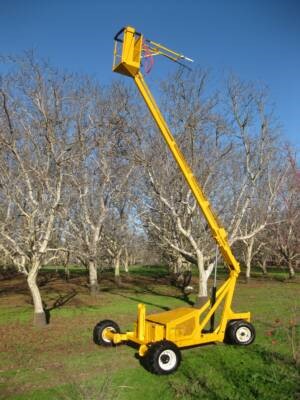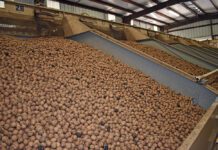Every tree nut grower, huller and processor has some type of aerial lift to elevate workers to perform certain activities on the worksite. From orchard pruning towers to scissor lifts or telescopic/articulating boom lifts to homemade “man baskets” used with forklifts, they are common place throughout the industry. An average of 26 workers die each year from accidents related to aerial lifts. As a result, the industry must be proactive when it comes to working safely with aerial lifts. The most common aerial lift accidents occur as follows:
- Electrocutions—when the worker or the lift come into contact with overhead power lines. This accounts for more than 25 percent of the deaths.
- Falls—when the worker extends his/her body beyond the confines of the lift or gets out of the lift.
- Collapse or tip-over—workers must maintain the lift on stable ground, stay within load limits and not move in an elevated position
- Caught in or between—workers involved with this type of accident were caught between the edge of the bucket and another object, like a roof joist or beam, when they were repositioning the aerial lift bucket.
- Being struck by the aerial lift or object—this accident occurs when the operator isn’t aware of their surroundings and comes into contact with objects that come loose.

It is important to note that more than 70 percent of the accidents involving aerial lifts occur with boom lifts. Half of the falls from boom lifts involved being ejected from the bucket after being struck by vehicles, cranes, or crane loads, or by falling objects, or when a lift is suddenly jerked. Two-thirds of the deaths from collapses/tip-overs of boom lifts occurred when the bucket cable or boom broke or the bucket fell, and almost one-third were due to tip-overs. Half of the boom lift electrocutions involved body contact with overhead power lines.
When working with aerial lifts, employers must consider the safety in operating the lift, and the safety of the worker in protecting against falls. Employers must ensure only trained and certified operators may use the aerial lifts. Each authorized operator must go through classroom and hands-on training which consist of operation (review of emergency controls, emergency escape techniques), aerial platform hazards and basic lift operation demonstration.
The operator of aerial lift must follow all of the key points when operating aerial lift:
- Be trained in the safe and proper operation of a manlift.
- Be familiar with the specific lift and its operator’s manual.
- Know the maximum load capacity (weight of personnel, tools, etc.)
- Conduct a pre-start inspection of the equipment by conducting a visual inspection of the equipment and checking things like tires, wheels, battery, leaks, controls, etc.
- Conduct an inspection of the environment where the work will take place looking for such things as overhead clearance, traffic patterns (forklifts, pedestrians, etc.), wind hazards (if outside), and location of other workers.
- Protect against fall hazards by inspecting guardrails on the lift and having the necessary fall protection gear on (i.e. harness, fall restraint).
- Employees shall not sit, stand or climb on guardrails or use planks, ladders to gain additional height.
- Never operate the lift when in the elevated position.
- Maintain safe clearance from power lines and apparatus.
This article is not meant to be a training tool, but rather to highlight safety concerns when operating manlifts in the workplace. To carry this out further, the Western Agricultural Processors Association (WAPA) is conducting a series of training sessions throughout the state to assist the tree nut industry with this important safety issue. For details, please visit www.agprocessors.org.

Roger A. Isom
Roger is President/CEO of the California Cotton Ginners and Growers Association and Western Tree Nut Association. He brings over 30 years of regulatory and legislative advocacy experience, specializing in environmental and safety matters. Roger’s responsibilities include the management of both Associations’ staff and day-to-day operations. Roger is also the President of the Ag Energy Consumers Association (AECA), board member and Past President of the Ag One Foundation at California State University Fresno, and manages the Navel Orangeworm Action Committee (NOWAC).
















